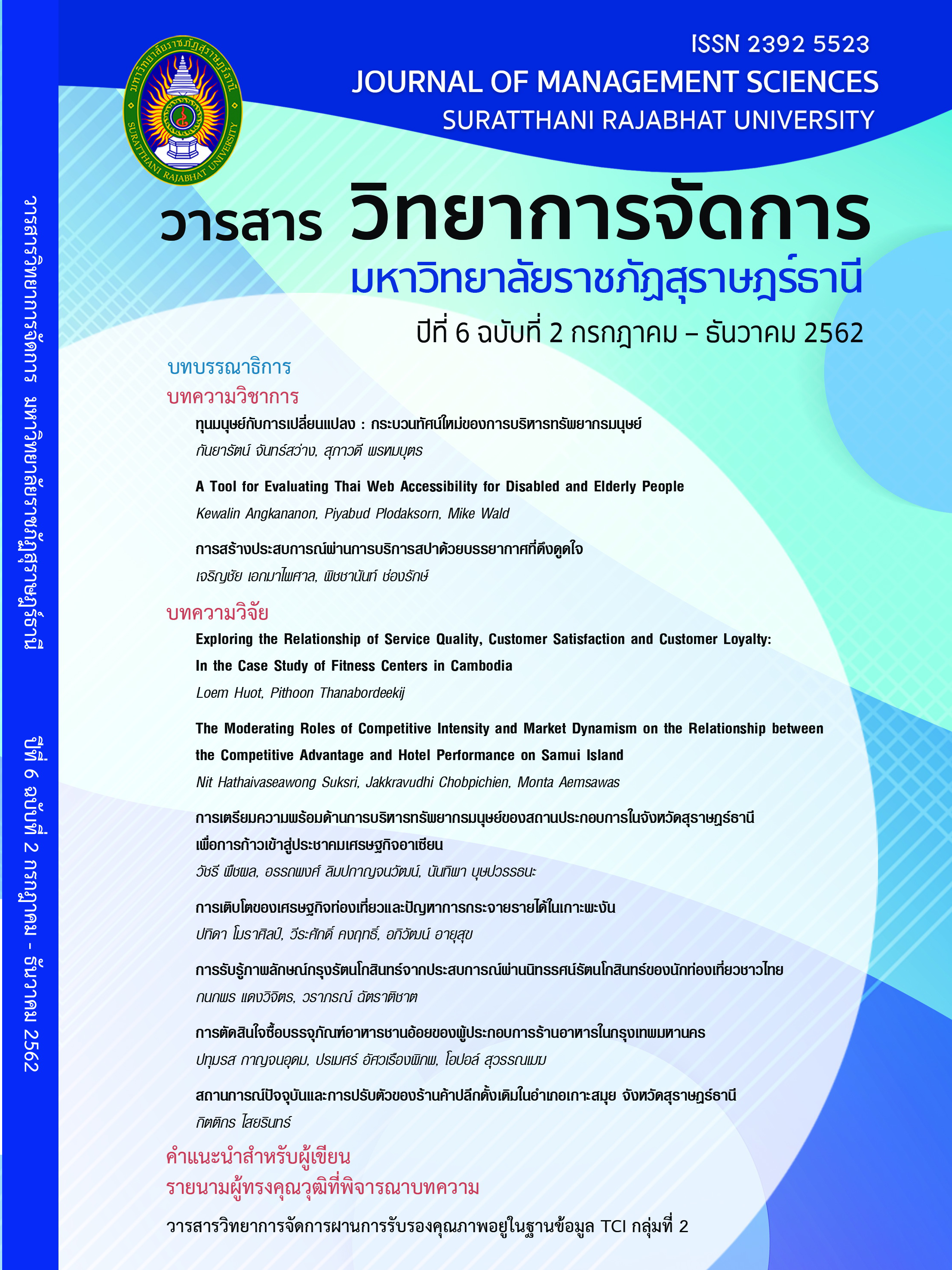Human Capital with Change: A Paradigm Shift of Human Resource Management
Main Article Content
Abstract
The organization of management among the current changes is more complex and challenging. The organizations need to compete in various dimensions more seriously. Capitalism is the basic concept that organizations with more capital will have an advantage over other organizations. It is a factor that has a major inflence on the management of business enterprises, government agencies and educational institutions to be competitive and grow the organization continuously. However, the concept of capital for current operations is not just a matter of money, technology and management resources, but has begun to focus more on human resources and regard the capital of the enterprise to create an advantage for the operation. Therefore, human resources, is even more important and a new concept is the concept of “Human Capital”.
This article aimed to explain the paradigm shift about the concept of human resource management of the organization to the human capital. The view is that human resource is the most important asset in the organization using the knowledge, ability, skill and experience of the people in the organization. Therefore, human capital management is what managers at all levels in the organization must be involved with. They must work together with the human resource offier in the organization to plan and develop the human capital of the organization to have the potential to create the best results for the organization.
Article Details
References
กัลย์ ปิ่นเกษร, เฉลิมชัย กิตติศักดิ์นาวิน และจิราวรรณ คงคล้าย. (2560). ทุนมนุษย์ : ตัวชี้วัดทุนมนุษย์ระดับองค์การ. วารสารบัณฑิตศึกษา มหาวิทยาลัยราชภัฏวไลยอลงกรณ์ ในพระบรมราชูปถัมภ์.11(2), 195.
กิตติ มิลำเอียง. (2559). การสรรหาและคัดเลือกทรัพยากรมนุษย์ในองค์การภาครัฐยุคใหม่. วารสารมนุษยศาสตร์และสังคมศาสตร์ มหาวิทยาลัยราชภัฏสุราษฎร์ธานี. 8(1), 149.
ชลพร จันทร์ศิริ. (2556). เอกสารประกอบการสัมมนา: ก้าวทันอาเซียนต้องรู้จักคนอาเซียน.
เดชา เดชะวัฒนไพศาล. (2559). การจัดการทรัพยากรบุคคล พื้นฐานแนวคิดเพื่อการปฏิบัติ. กรุงเทพฯ:โรงพิมพ์แห่งจุฬาลงกรณ์มหาวิทยาลัย.
นิสดารก์ เวชยานนท์. (2551). มิติใหม่ในการบริหารทุนมนุษย์. กรุงเทพฯ: กราฟิโก ซิสเต็มส์.
ประไพทิพย์ ลือพงษ์. (2555). การพัฒนาทุนมนุษย์ให้มีสมรรถนะความสามารถในการแข่งขัน. วารสารนักบริหาร. 32(4), 103 - 108.
รติพร ถึงฝั่ง และโกศล จิตวิรัตน์. (2552). การพัฒนาทุนมนุษย์ภายใต้การเปลี่ยนแปลงเชิงพลวัต. วารสารการจัดการสมัยใหม่. 7(2). 27 - 40.
ระบิล พ้นภัย. (2557). ความสัมพันธ์เชิงสาเหตุและผลลัพธ์ความสามารถในการแบ่งปันความรู้ของบุคลากรในองค์การ: ปรากฏการณ์เชิงประจักษ์ของธนาคารพาณิชย์ไทย.
ปริญญาปรัชญาดุษฎีบัณฑิตสาขาวิชาการจัดการ มหาวิทยาลัยศิลปากร.
ศิริพงษ์ เศาภายน. (2551). ทุนมนุษย์และบทบาทในการพัฒนาองค์กร. วารสารรามคำแหง. 25(2). 205 - 207.
สำนักงานคณะกรรมการพัฒนาการเศรษฐกิจและสังคมแห่งชาติ. (2560). แผนพัฒนาเศรษฐกิจและสังคมแห่งชาติ ฉบับที่ ๑๒ (พ.ศ. ๒๕๖๐-๒๕๖๔). สืบค้นเมื่อ 8 พฤษภาคม 2561, จากhttp://www.nesdb.go.th/main.php?fiename=index.
สุดารัตน์ โยธาบริบาล. (2557). สิงคโปร์กับสงครามการแย่งชิงคนเก่งทั่วโลกสู่ “ศูนย์กลางคนเก่งสิงคโปร์”:บทเรียนและความท้าทายสู่แนวทางสร้าง “ศูนย์กลางคนเก่งภาครัฐไทย” ในบริบทอาเซียน. วารสารมนุษยศาสตร์และสังคมศาสตร์. 31(2). 1 - 28.
Barney, Jay B. (1991). “Firm resources & sustained competitive advantage”. Journal of Management17, 1: 99 - 120.
Lynda Graton and Sumantra Ghoshal. (2003). Managing Personal Human Capital: New Ethos for the “Volunteer” Employee. European management Journal. 21(1), February 2003. Printed in Great Britain.
Tofflr, Alvin. (1981). The Third Wave. London: Pan Books.

